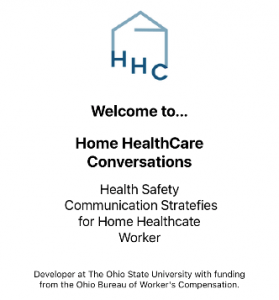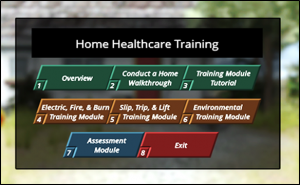Using Virtual Technologies to Prevent Injuries in Adolescents with ABI
This pilot study will identify safety hazards and concerns for adolescents with Acquired Brain Injury (ABI) in home environments (Aim 1) and identify adaptations to the home healthcare virtual simulation training system (HH-VSTS) to improve relevancy and usability for adolescents with TBI (Aim 2). Our team developed the HH-VSTS to train home healthcare workers to identify and respond to health and safety hazards in client homes. We seek to modify and test this system for use with adolescents with ABI. Using a mixed methods, participatory approach, we will engage multiple stakeholders (adolescents with ABI, caregivers, and clinicians) in interviews, activities, and HH-VSTS review. Data from this project will supply critical preliminary data for a larger study that will modify and test the effectiveness of the HH-VSTS in promoting safe performance of everyday activities in the home among adolescents with ABI. The long term goal of this research is to increase the home safety of adolescents by improving their ability to identify and respond to common household hazards (e.g. fire safety, household chemicals, trip hazards) using a virtual simulation training system (HH-VSTS).
The study is funded by the Center for Injury Research and Policy at Nationwide Children’s Hospital (Anderson & Darragh: PIs) and includes our team as follows: Jennifer Lundine (Speech and Hearing); Carolyn Sommerich and Steve Lavender (Department of Integrated Systems Engineering); Celia Wills (College of Nursing) and Barbara Polivka (University of Kansas Medical Center).
Home Healthcare Conversations
 Protecting Home Healthcare Workers: An interactive video‐based app to coach workers through challenging health and safety‐related situations. https://u.osu.edu/athomecare
Protecting Home Healthcare Workers: An interactive video‐based app to coach workers through challenging health and safety‐related situations. https://u.osu.edu/athomecare
Funded by the Ohio Bureau of Worker’s Compensation Research Grant Program, this study is developing an app to provide home healthcare workers with video-based information about how to discuss complex or challenging health and safety with their clients. This project built on our NIOSH R01 that developed the HH-VSTS by developing an on-demand app that links users to videos providing guidance for handling challenging health and safety situations in home healthcare.
The HHC scientific development team is highly interdisciplinary and includes Amy Darragh, Sarah Anderson, Haley Oliver, Angela Provenzano, Angela Rittler (School of Health and Rehabilitation Sciences); Carolyn Sommerich and Steve Lavender (Department of Integrated Systems Engineering); Celia Wills (College of Nursing) and Barbara Polivka (University of Kansas Medical Center).
NEWS! App available for download:
Appstore (https://apps.apple.com/in/app/home-healthcare-conversations/id1544710399)
Playstore (https://play.google.com/store/apps/details?id=com.bkl.homehealthcare).
HH-VSTS: The Home Healthcare Virtual Simulation System
We developed an engaging, effective, and evidence-based Home Healthcare Virtual Simulation Training System (HH-VSTS) to train HHWs to identify and respond to health and safety hazards in the homecare environment (NIOSH-funded R01OH010425; 2012 – 2017). Our HH-VSTS uses an interactive virtual environment representing a basic 2-story house and includes three training modules (Figure 1) that address (1) electrical/fire/burn, (2) slip/trip/lift, and (3) environmental hazards found in client homes. Learning is evaluated with an assessment module.11 The current version of the HH-VSTS, which is available for download, contains seven rooms, plus hallway and closets, with hazards strategically placed throughout. Users are able to click on hazards, identify whether or not the asset is a hazard, learn the rationale for hazard/no hazard, and learn hazard management strategies. The home is tailored for each case and module. The HHC scientific development team was highly interdisciplinary and included Amy Darragh and Sarah Anderson (School of Health and Rehabilitation Sciences); Carolyn Sommerich and Steve Lavender (Department of Integrated Systems Engineering); Celia Wills (College of Nursing), Barbara Polivka (University of Kansas Medical Center), and Don Stredney and Bradley Hittle (Ohio Supercomputer Center).
For more information on the HH-VSTS and our development team, or to download, the HH-VSTS, please visit the following website: https://u.osu.edu/homehealthcaresafety/
